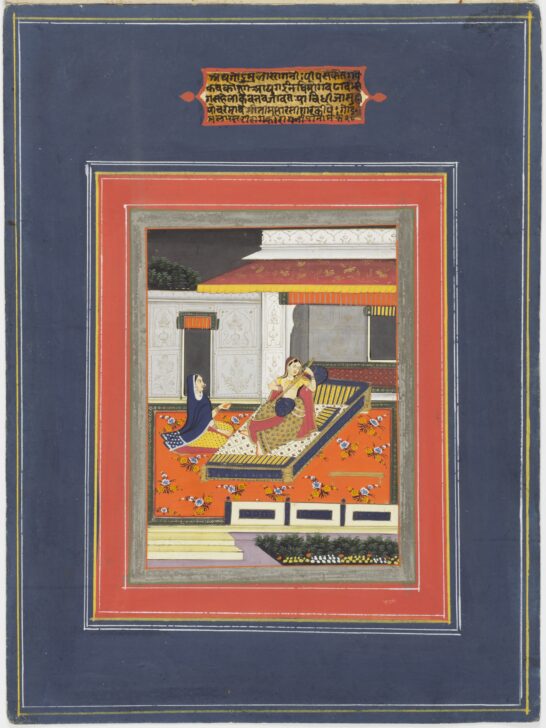Ragamala: Gorhalar Ragini
Artist Unknown, India, Rajasthan, Jaipur School

Description
Subject Matter:
Ragamala paintings draw from aspects of human experience in order to visualize specific moods, emotions, and qualities such as love, anguish, valor, weakness, and strength. A raga in Indian music is a melody consisting of a string of notes in a particular arrangement. Raginis are derivations from or variations of ragas in feminine mode (the basis of these classifications remains unexplained in many cases), and could have different or similar musical structures as ragas. Specific ragas are associated with specific times of the day, seasons, and emotions. When visualized, as here, ragas and raginis are meant to evoke the same affective responses that are allied to their musical modes. The text above the illustration refers to stories or incidents associated with the depicted raga/ ragini, but may not necessarily be narrative-like or descriptive. Drawn from literary tropes and tales that sophisticated writers and viewers would be aware of, the inscriptions are an integral part of the overall experience of this miniature painting. An illiterate viewer, however, could still enjoy the scene without reading the text.
In this image, the woman sits and plays a stringed instrument, while her attendant waits on her. In other versions of this image, the woman is shown surrounded by birds such as peacocks, and could be placed in a garden setting with trees and flowers. The atmosphere reflects the woman's state, and vice-versa. Both are charged and charming. Ragmala paintings also find place within the Pahari and Deccani painting traditions of the Indian subcontinent.
Physical Description:
A woman playing a musical instrument is shown sested on a bed in an open-air terrace during nighttime. A pavilion is represented behind her, and a horizontal wall connected to the pavilion, consisting of an opening/ door, extends to the left border of the scene. Another female figure, possibly an attendant, is shown sitting on the floor beside the bed, facing her mistress. A short verse is painted above the depicted scene.
Usage Rights:
If you are interested in using an image for a publication, please visit https://umma.umich.edu/request-image/ for more information and to fill out the online Image Rights and Reproductions Request Form.